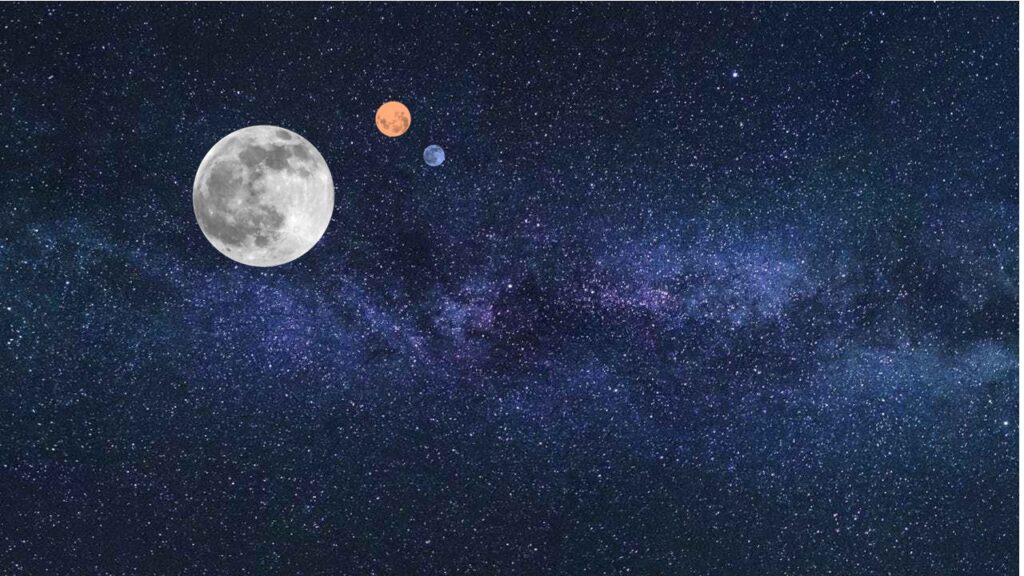
The skies above Adnati are crowded with one sun, three moons, and countless stars, including scores of named constellations, of which a dozen are the most prominent.
Sola, the Sun
Adnati has a single yellow sun, called Sola in the common tongue but more commonly referred to as simply “the sun.” The solar cycle lasts exactly 362 days. The Common Calendar is based on the solar cycle, beginning on the Winter Solstice and cycling through Spring, Summer, and Autumn until it returns back to Winter.
The Moons of Adnati
There are three moons in the skies above Adnati.
Of these, Lunaal, a mottled gray orb, is the largest and brightest. Lunaal takes 29 days to cycle from a new moon through the full moon and back to a new moon. The twelve months of the Adnati Common Calendar roughly corresponds to Lunaal’s cycle. Sages understand that Lunaal must be the closest to Adnati based on how it eclipses the others when their paths cross. It is the most dominant celestial body in the heavens, other than the Sun, and when people simply say “the moon” in the Common Tongue, it is Lunaal that they are referring to.
The second moon, both in distance from Adnati and in apparent size to the naked eye, is Raudraal, sometimes called the Red Moon. To the naked eye, Raudraal appears to have a diameter a quarter of Lunaal’s. Sages know that this may be deceptive, as Lunaal is also clearly closer, since Lunaal eclipses Raudraal when their paths cross. It takes Raudraal 40 days to cycle from a new moon through the full moon and back to new. The ten-day week in the Common Calendar is based on one-quarter of Raudraal’s cycle.
The third moon, Caerudraal, is known as the Blue Moon, though sages continue to speculate fruitlessly whether the hue comes from oceans on the moon’s surface or from minerals in its soil. It takes 77 days for Caerudraal to complete its full lunar cycle.
The Stars & Constellations
There are thousands and thousands of stars in the skies above Adnati, perhaps millions of them. Of these, there are scores of named constellations, twelve of which are well-known even to non-astronomers due to how they’re used to mark the months of the calendar year and the seasons and the harvest cycles.
The most prominent star in the heavens, due both to its brightness and its closeness to the celestial north pole, is named Ilimorí after Ilimoran Toruvial, the most senior of the elven gods who, among other traits, is the God of Starlight. Navigators have used Ilimorí for millennia to guide their travels.
The twelve most prominent constellations in the heavens are used to mark the months of the Common Calendar. They are named after the gods of the Almagest Pantheon. These include:
- Elapida, the Basilisk – Appearance marks the beginning of winter and the represents the first month of the year.
- Chryasor, the Pegasus – Appears during the second month of winter.
- Melquart, the Hippocampus – Appears during the third month of winter.
- Bennu, the Phoenix – Appearance marks the first month of spring.
- Pausanius, the Manticore – Appears during the second month of spring.
- Altair, the Griffin – Appears during the third month of spring.
- Tuthose, the Kraken – Appearance marks the first month of summer.
- Melusina, the Dragon – Appears during the second month of summer.
- Ketesias, the Unicorn – Appears during the third month of summer.
- Garuda, the Peryton – Appearance marks the first month of autumn.
- Chelys, the Aspidochelone – Appears during the second month of autumn.
- Atrarora, the Salamander – Appears during the third month of autumn, which is the final month of the Common Calendar.
Planets
For millennia, sages have recognized that there are at least five known celestial bodies that traverse the skies in a manner completely unlike the moons, the stars and constellations, and the sun. The sages call them planets, and they have been named after five of the elven gods.
- Eldamarí – Named after the elven god Eldamar Galion. It has a slightly reddish hue.
- Gatheloní – Named after the elven god Gathelon Tarminel.
- Lassamistrí – Named after the elven god Lassamistra Ordymil.
- Lythí – Named after the elven god Lythia Nuros. It is the brightest of the planets.
- Tyrí – Named after the elven god Tyra Manora. It has a slightly bluish hue.
